Mmm. Pupae. 33 day old Baby, front, and Ball, behind, Sept. 23
If you're just picking up this story, please scroll down and check out the first two installments in the tale of the rehab and release of the song sparrows I took in August 30, 2021. It was a process!
Once the three orphaned song sparrows were used to flying up to a pedestal to feed, I switched to topping it with a large flat board. All these changes took place over the week and a half they were in the tent. I wanted them to be completely comfortable with the feeding setup before they were released. Once they were reliably feeding on the board-topped pedestal, they were ready to go. It was September 17, and they were 27 days old. I had chosen this day for release because Margaret Morse Nice, Ohio song sparrow guru and author of one of the finest single-species studies ever done, wrote that the longest she’d ever observed her subjects feeding their young was Day 27. So be it.
I opened the tent at 11:15. Baby sunbathed in the unaccustomed bright rays, but the birds acted as though they didn’t notice the open sky, now revealed with the screen rolled back. At 12:14 pm, Bob was the first to fly out, leaving Ball and Baby stunned and standing still at the mouth of the tent. It was a beautiful warm calm day, perfect for them to get their bearings outdoors. At 12:45 pm, Baby flew out into the driveway.

She was gone for a few moments, then she flew back into the garage and tried to get back into the tent. She changed her mind and flew to the nearby forsythia. All the while, Ball stood and watched. He was still sitting at the open end at 1:20 pm. He was terribly conflicted, and spending a lot of time foot-staring and hiding in the folds of the tent. There was no sign of the two released birds. I calmed myself, saying they’d be back when they got hungry. 2:15: Ball still lingered in the tent. At 2:53, he made a straight flight out the door and hid under my car in the driveway. I set up the pedestal where he could see it, well stocked with millet and mealworms. I kept hearing rustling in the roses along the garage, but I didn’t see any of my babies from 3 pm until it was too dark to see.
It was Terrible. The first 12 hours or so of most of my bird releases are usually pretty stressful. I went to bed at 10 pm and woke at 1:30, worrying, and that was it for me. I was so impatient for the dawn. At 7 am I walked out, calling, and Baby popped up in the rose hedge! I threw millet all over the sidewalk, mealworms too, and two birds—Ball and Baby-- came down to eat at long last. What an awful ordeal, waiting for evidence that they were still alive. It’s often thus with releasing birds. You have to have faith, and every hour that ticks by tests that faith.
Around 11:40, a third bird came flying from the prairie patch across the yard. It was Bob! I’d heard him giving the chimp note over there most of the day. Finally, they were all together, and they fed atop the pedestal feeder I’d set up by the forsythia. Whewww!!
What a relief! By mid-morning, the babies were coming to the pedestal, which I'd set up next to the forsythia where they spent a lot of time. I left the good stuff out for them there! Here, Baby and Ball feast on mealworm pupae (freshly molted, of course, and tender).
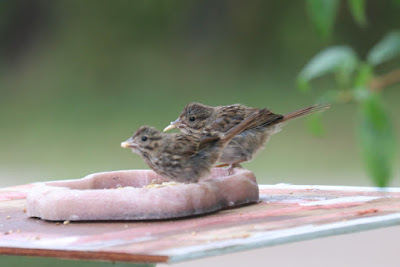
Just look at the size difference here. Baby's in front, but so much smaller and more delicate than hulking Ball. Also note the angle of her tail--she always carried it high.
Baby and Ball were almost always together, as they had been in the cage and in the fledging tent. It was a comfort to see their bond persisting after release.
Baby and Ball at the pedestal.Ball was well-named. He was roundish, and he had finer streaking as a juvenile than Baby .
Ball, Sept. 25, '21
I stayed out with them all that first day. It is my habit to stay out with newly released birds, to give them a sense of continuity, so they know I will continue to provide for them. Toward dusk, Baby and Bob went to roost in the forsythia, while Bob, ever the loner, flew across to the prairie patch. He was to keep this pattern for the rest of the autumn. Alone among the three, though, Bob would spook around the front door, the studio hummingbird garden and the bird baths. It was always lovely to look down and see him as I worked. I often wondered if his willingness to come into my spaces was because he had spent time on my shoulder as a brand new fledgling. He sought me out.
20 Sept. Bob tries his first sunflower heart under the feeder! He also stripped crabgrass seeds as though he'd been doing it all his life. My mother bird's heart almost burst with pride!
And that same day, I snapped his portrait by my granite snapping turtle. How cute is he?
Bob, in the grass Liam calls "Witch's Hair" on Sept. 23, 2021
He was 33 days old. Such a handsome little guy.
Ball eats a moth, Sept. 28
Ball, Oct. 1, '21. This photo makes me smile. He was such a round little fella as a youngster.
Baby, Oct. 17, '21. Baby carries herself low, and often cocks her tail upward. Always has.
I fell into a pattern of taking my camera and binoculars out each morning when I filled the feeders on the pedestal. I'd sit in a lawn chair, taking my tea, watching for the babies, and I'd shoot as many photos as I could. It was lovely, like a morning meditation. My chair was perennially wet from the morning dew, so I took a towel out with me to spread before I sat down.
I like to think it gave them a sense of peace and comfort to have a large anthropoid ape, one they knew, watching over them as they fed.
They were also completely comfortable with Curtis, who made it his job to keep the chipmunks away from the seed I spread on the sidewalk.
Still, we couldn't protect them every minute.
On this shot from Sept. 19, you can see the pale fault bar band across Bob's tail. All three babies showed this band, which was formed when they suffered a day of deprivation when their nest was destroyed, before I took them in on August 30. The feather growth was interrupted, and manifests as a pale line.

Bob fills up at the pedestal feeder, Sept. 24, '21
On Sept. 29, Bob turned up tailless! I blame the chipmunks who were always lurking in the rudbeckia/rose hedge along the sidewalk. Not a fan of the striped ones.
Oct. 1, 2021--Bob is already showing the start of a new tail! Four days of growth and he's already showing a stub! I knew he'd grow it back, and sure enough, within three weeks you'd never know he'd been without. The only thing that wasn't great about this was that I'd lost the key marker--the fault bar across his baby tail feathers--that I'd been relying on to distinguish him from the wild song sparrows. As they got sleek and beautiful, I had to rely on the fact that all three of my babies were still undergoing face and head molt in mid October, while any visiting song sparrow would have long since finished molting. There were still a few pinfeathers on Bob's face when I snapped him with his beautiful new red tail on Oct. 17.
Bob at the bonsai pool by the front door, Oct. 21, 2021
Bob loved to bathe! Maybe that's why he was always sleeker than his siblings. He probably thought they were gross, so he kept to himself.
One of the really cool things that happened during this lovely September/October idyll was that two wild male song sparrows showed up and hung out with the babies. This is one I called Chops, for his big muttonchop markings.
Chops can hardly believe the fare my three orphans were getting
The bird below I called Wilder.
Both sang around the yard, which is why I knew they were males.
Wilder, October 3, 2021
Because the babies weren't afraid of me, these two wild song sparrows decided I must be all right.
They were so crisp and beautifully smooth, in contrast to the scruffy juveniles. I enjoyed getting to know the wild ones, who fed among the three babies, unconcerned about me sitting just a dozen feet away.
I remember that period as one of peace and contentment, watching my sparrows go a little wilder each morning, before their mama's eyes.





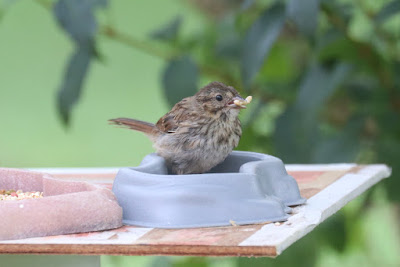

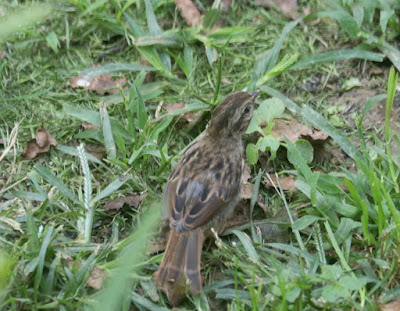

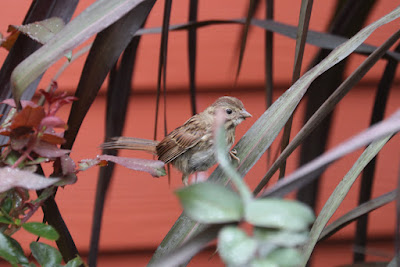






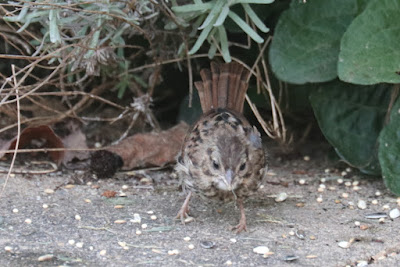
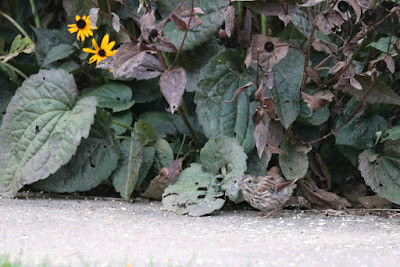

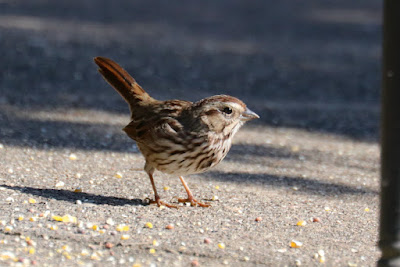
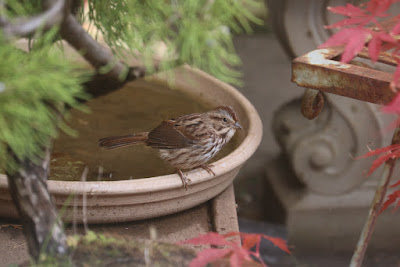











1 comments:
I can just picture you worrying over them the first night on their own. But what a sweet feeling of accomplishment. Kind of like sending your kids off to college the first time.
Post a Comment